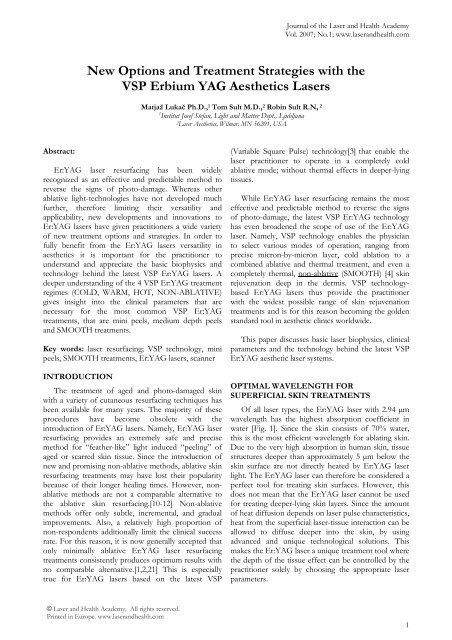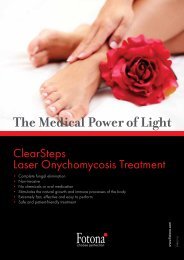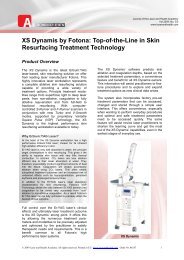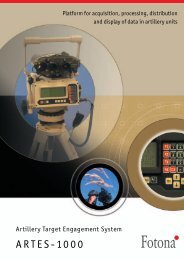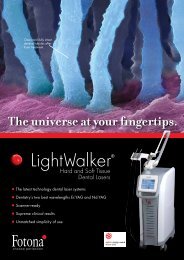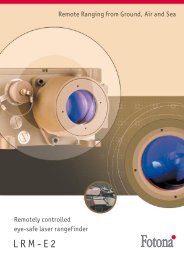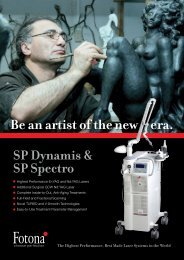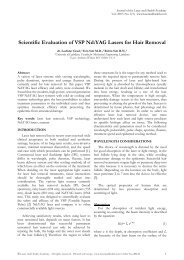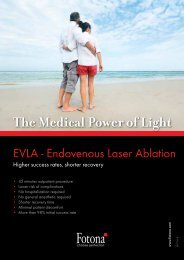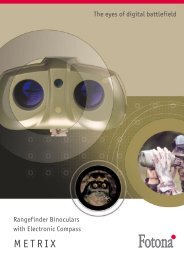New Options and Treatment Strategies with the VSP ... - Fotona
New Options and Treatment Strategies with the VSP ... - Fotona
New Options and Treatment Strategies with the VSP ... - Fotona
You also want an ePaper? Increase the reach of your titles
YUMPU automatically turns print PDFs into web optimized ePapers that Google loves.
Journal of Lasers <strong>and</strong> Health AcademyVol. 2007, No. 1; www.lasers<strong>and</strong>health.comwhat a laser pulse train looks like <strong>with</strong>out <strong>the</strong>intervention of Energy Feedback Control (EFC)technology; <strong>the</strong> energy level of each subsequent pulsedecreases. This results in inefficient treatments, wastedtime <strong>and</strong> dissatisfied patients. Fig. 3 (right) shows howa pulse train looks <strong>with</strong> EFC support. EFC measures<strong>the</strong> energy of each single laser pulse <strong>with</strong> twoindependent internal energy meters <strong>and</strong> adjusts <strong>the</strong><strong>VSP</strong> parameters to keep <strong>the</strong> laser pulse energiesconstant. <strong>VSP</strong> technology <strong>the</strong>n enables <strong>the</strong>construction of square pulses. The control of energybursts results in <strong>the</strong> ability to vary <strong>the</strong> height <strong>and</strong> <strong>the</strong>length of a burst resulting in <strong>VSP</strong>-shaped pulses.Fig. 4: Comparison of peak fluence values ofGaussian <strong>and</strong> top-hat beam profiles for <strong>the</strong> sameaverage fluence <strong>and</strong> 4 mm spotsize.For this reason, special “top-hat” profile [Fig. 5a]Er:YAG h<strong>and</strong>pieces have been developed (<strong>Fotona</strong> R11or R04). Because of <strong>the</strong>ir much more homogeneousbeam profile, top-hat h<strong>and</strong>pieces are much safer <strong>and</strong>effective compared to st<strong>and</strong>ard Gaussian profileh<strong>and</strong>pieces.Fig. 3: Energy levels of a laser pulse train <strong>with</strong>out<strong>the</strong> intervention of EFC technology (left) <strong>and</strong> <strong>with</strong> <strong>the</strong>support of EFC technology (right).ENERGY DISTRIBUTIONCONSIDERATIONSSt<strong>and</strong>ard laser h<strong>and</strong>pieces emit laser beams <strong>with</strong> aGaussian profile <strong>and</strong> thus an energy distribution thatresembles a conical shape [Fig. 5b]. Higher focalfluences at <strong>the</strong> centre of <strong>the</strong> spot are created, while <strong>the</strong>fluence decreases towards <strong>the</strong> edge of <strong>the</strong> spot. Thistype of h<strong>and</strong>piece <strong>the</strong>refore does not allow <strong>the</strong>practitioner to control <strong>the</strong> treatment regime over <strong>the</strong>whole illuminated spot area.Fig. 4 shows that, for a selected fluence value on<strong>the</strong> laser keyboard (which is in reality only <strong>the</strong> averagefluence), a 4 mm spot <strong>with</strong> <strong>the</strong> “Gaussian” h<strong>and</strong>piecewill emit laser radiation in <strong>the</strong> center of <strong>the</strong> spot <strong>with</strong> afocal fluence value twice <strong>the</strong> value of <strong>the</strong> “top-hat”h<strong>and</strong>piece, <strong>and</strong> practically zero at <strong>the</strong> edges of <strong>the</strong> spot.For example, if a fluence value of 1.5 J/cm 2 is selectedon <strong>the</strong> keyboard (which would be just above <strong>the</strong>threshold for skin ablation) a “Gaussian” h<strong>and</strong>piecewould emit 3 J/cm 2 at <strong>the</strong> center of <strong>the</strong> spot whichwould result in an aggressive ablation in <strong>the</strong> center of<strong>the</strong> spot, <strong>and</strong> only a light peel at <strong>the</strong> edges of <strong>the</strong> spot.Fig. 5: A top-hat h<strong>and</strong>piece beam profile (left) <strong>and</strong>a Gaussian h<strong>and</strong>piece beam profile (right).FOUR TREATMENT REGIMESRecent technological advances in laser aes<strong>the</strong>tictreatments have been facilitated by equally excitingdevelopments in <strong>the</strong> <strong>the</strong>oretical underst<strong>and</strong>ing ofEr:YAG laser ablation of biological tissues.[6, 24]It is now well-understood that <strong>the</strong>re are fourEr:YAG treatment regimes depending on <strong>the</strong> laserpulsewidth <strong>and</strong> <strong>the</strong> laser pulse energy [6] or morecorrectly, laser fluence (i.e. <strong>the</strong> laser energy per surfacearea in J/cm 2 ) [Fig. 6]. The more energy that istransformed into heat, <strong>the</strong> less efficient <strong>the</strong> ablativeeffect <strong>and</strong> <strong>the</strong> greater <strong>the</strong> skin collagen coagulationeffect.3


